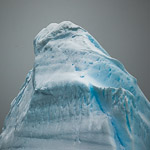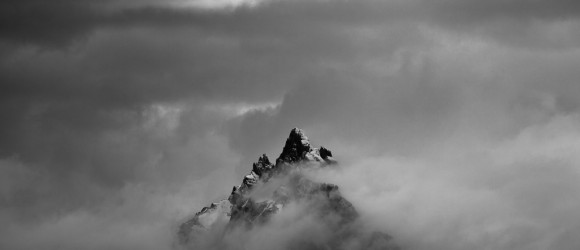Antarctica Video
- At April 11, 2014
- By John
- In Antarctica, Travel, Uncategorized
 0
0
Courtesy of Chris Sanderson, there is now an 18 minute video of my trip with Luminous Landscape to Antarctica earlier this year. It is really a taster (advertisement) for future LuLa trips there, but contains some stunning Antarctic scenery and wildlife, and for me a great reminder of such good times. I had hoped to embed the video below but unfortunately their privacy setting’s won’t allow that, so you just have to click on the screen grab below linked to the video. It’s well worth a watch. and there’s even the odd glimpse of yours truly.
Read More»Day 5 – Whales, Icebergs & Penguins
- At February 14, 2014
- By John
- In Antarctica, Travel
 3
3
Cierva Cove
Our morning was greeted by what was to become a very familiar voice, that of Morten Jørgensen, the Antarctica XXI expedition leader, urging us to rise from our bunks as there was “some really nice light outside“, and being we were all photographers it was something we “really shouldn’t miss“.
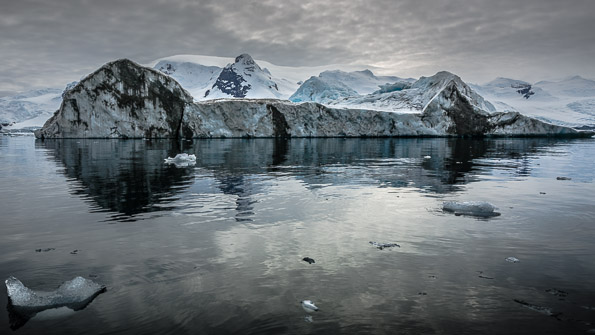
Iceberg and reflections, Cierva Cove
On deck, for those that took heed to the call, we were indeed greeted by some early morning, pale yellow light, and our first glimpse of the Danco coastline of mainland Antarctica with the occasional iceberg drifting by. That was soon followed by our first of many sitings of Humpback whales, which brought almost everyone to the viewing deck; a multitude of cameras snapping away like a veritable horde of paparazzo. For me this was the first time I’d really seen a whale up close … the trip was starting well.
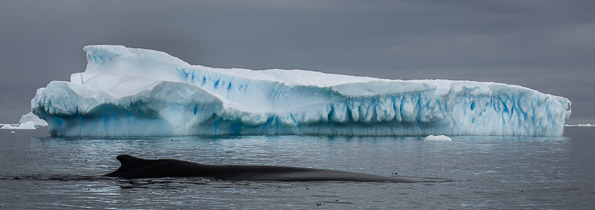
Humpback Whale and whale shaped iceberg at Cierva Cove
Not long after the Ocean Nova was gliding into Cierva Cove littered with numerous icebergs from the surrounding glaciers. Impressive scenery indeed. The light was good too; a lovely covering of quilted cirrocumulus stratiformis clouds providing a natural soft box. Great light for photographing icebergs. Soon were were cruising in amongst them in our zodiacs, with almost flat, calm, waters providing great refections of icebergs and mountain peaks. Could it get any better than this? It did. A couple of Humpbacks were spotted amongst the bergs, and a Minke whale swam right along side of our zodiac. I saw his eye checking us out. Wow!
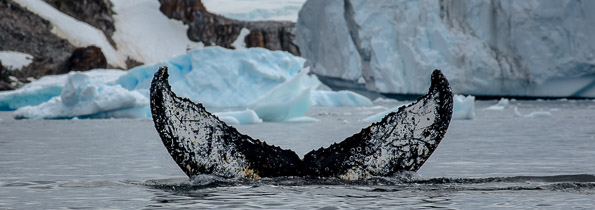
A fluke shot !
Time just flew by, and soon we were being urged to make an immediate return to the ship. In fact we were rather late and another Zodiac with approached with Morton onboard. Kevin Raber, our LuLa instructor was asked to switch zodiacs fully expecting a blocking from Morton for staying out too long. Instead he was given to opportunity to fulfil a long term wish – to drive a Zodiac in Antarctica. I think Morton just made his day!
Hydruga Rocks
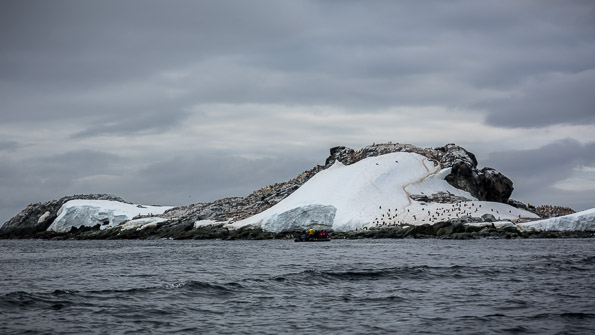
Cruising around Hydruga Rocks
After a most enjoyable lunch, dominated by chat about our fabulous morning, we headed for Hydruga Rocks for our first landing. A group of low rocky islands in the northern part of the Gerlache Strait named after the latin mame for the Leopard seal, Hydruga leptonyx. Funnily enough there are no leopard seals there. The islands, with lots of bare rocky outcrops, are home to a large colony of Chinstrap penguins, but we also saw fur seals, Blue-eyed Shags, Snowy Sheath-bills, as well as an elephant seal and several Weddell and Crabeater seals. After a couple of hours amongst the islands wildlife, the afternoon was completed with a cruise around the island on our return to the ship.
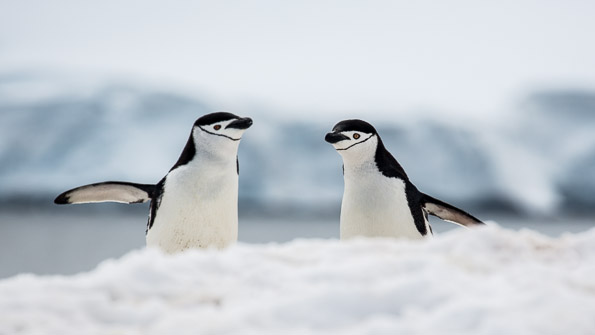
Chinstrap penguins, obviously stopping for a chin-wag!
At 18:30 in the evening we attended what was to become another familiar feature of our voyage, our daily briefing and recap in the panorama lounge. Here the Antarctica XXI crew reviewed the days antics and wildlife that had been observed, but more importantly what was planned for the day to come. With fine weather prevailing, a decision had been made to heading south to cruise the famous Lemaire Channel at sunrise followed by a 5:30 am zodiac cruise around the icebergs of Pléneau Bay. Expect a wake up call at 03:45am!
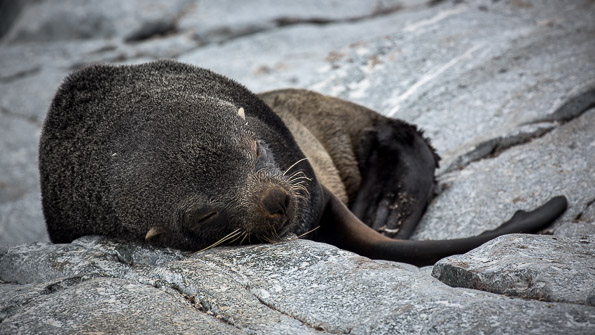
A sleeping Fur Seal
Day 4 – Arrival in Antarctica
- At February 11, 2014
- By John
- In Antarctica, Travel
 0
0
King George Island
Well the time had come to get my baggage down to 20kg. Unfortunately I failed. I just couldn’t seem to reach that illusive number, not without ditching a lens or two, my Mad Water dry-bag backpack and seriously start thinking about forgetting spare socks and under wear and even squirting out some toothpaste and shampoo. All was not lost though, as our amiable Antarctica XXI tour guide had let slip the night before that ONLY our check-in baggage would be weighed. Phew! I left the hotel with a check-in bag at 16.7kg, and a carry-on at 8.7kg … well over the limit I’m afraid, but a mere snip compared to some others!
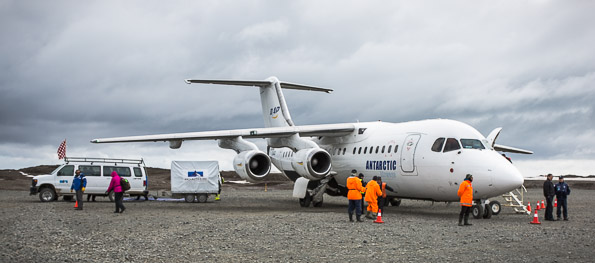
BAE-146 jet at Aeródromo Teniente Marsh, at Frei Base.
All kitted out in our rubber boots and waterproof trousers, check-in turned out to be a breeze. Shortly after we were heading out on the tarmac to our Antarctic Airways, BAE-146, 4-engine jet; a high-wing aircraft with very short runaway requirements so ideal for our location. The flight, smooth and uneventful, taking just under 2 hours to reach our destination Aeródromo Teniente Marsh, at Frei Base on King George Island. The Base Presidente Eduardo Frei Montalva, to give it it’s proper name, is the most important Antarctic base for Chile, located on the Fildes Peninsula; an ice-free area sitting above Fildes Bay at the south western tip of King George Island, South Shetland Islands.
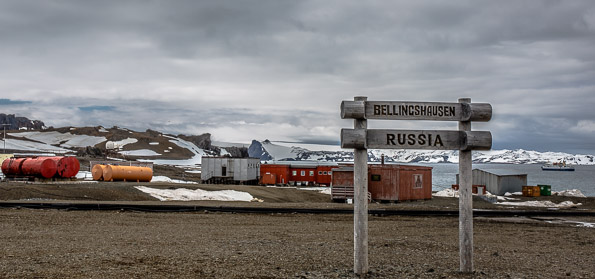
Bellingshausen Station, named after the 19th century Russian explorer Fabian von Bellingshausen.
Once disembarked into the much colder Antartic air, we had an easy 20 minute walk from the airfield down through the Russian Bellingshausen base to the shoreline of Fildes Bay where our ship, the Ocean Nova, was anchored. There we had 20 minutes or so to explore the shoreline and Trinity Church, a small wooden, Russian Orthodox church, that sits on a hill above the station.
There are no docking facilities at Frei Station so transfer to the Ocean Nova is by Zodiac boats. Our first taste of what was to become a familiar procedure. Soon after we were all safely on-board, and having checked out our cabins, had lunch and attended the obligatory boat drill, we informed that we were setting sail across the Bransfield Stait to mainland Antarctica, heading for Cierva Cove. This was great news. Out Antarctic voyage was underway.
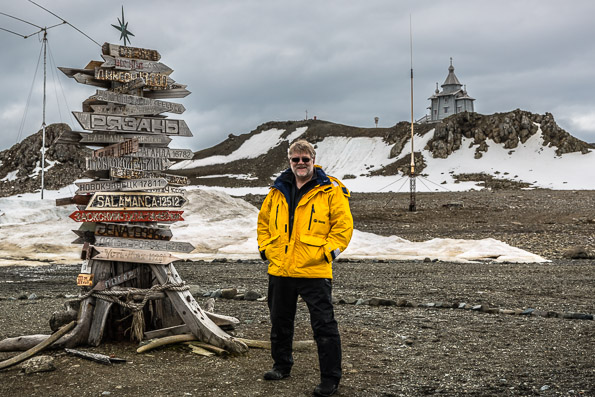
Journey to Antarctica – Day 3
- At February 03, 2014
- By John
- In Antarctica, South America, Travel
 1
1
Punta Arenas
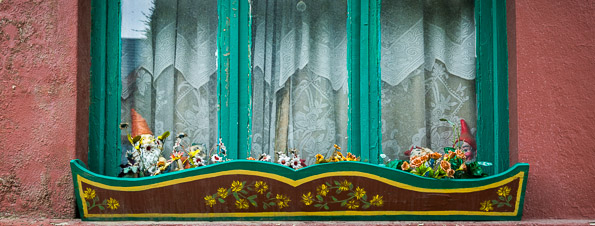
Today started with a rather early get-up. 2am to be precise. I’d really struggled to get to sleep so by the time my alarm sounded 2:00 am, I felt like I’d only been asleep for around 20 minutes. Groggy beyond belief. However, after a not-so-warm shower (cold in fact), I was soon dressed, packed and down in the hotel foyer the rest of the tour members, helping myself to some much needed coffee. At around 3:00 am out two coaches were fully loaded and on our way to Santiago airport only for ours having to return briefly to the hotel as one member of our team (who shall remain nameless) realised he forgotten his laptop of all things.
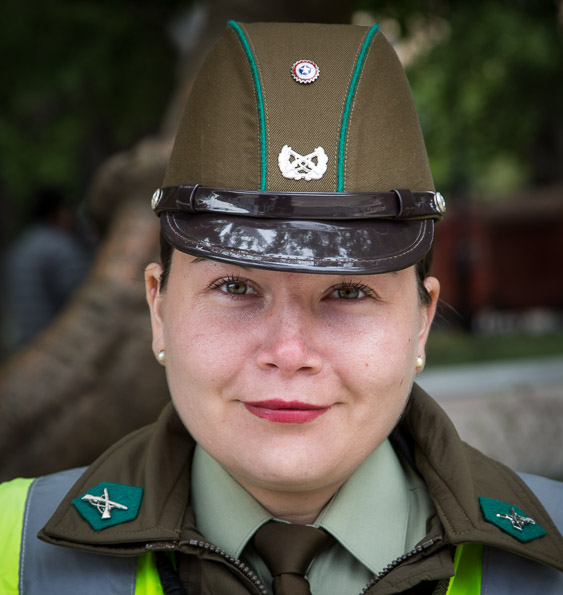
A member of the local constabulary.
Our flight to Punta Arenas in southern Chile took around 3 hours, and we all soon became aware of the big temperature change from the summer heat of Santiago to the cool and windy 8 degrees presented to us as we border the coaches for our 20 minute journey to our downtown hotel. Fleeces and jackets suitably adorned.
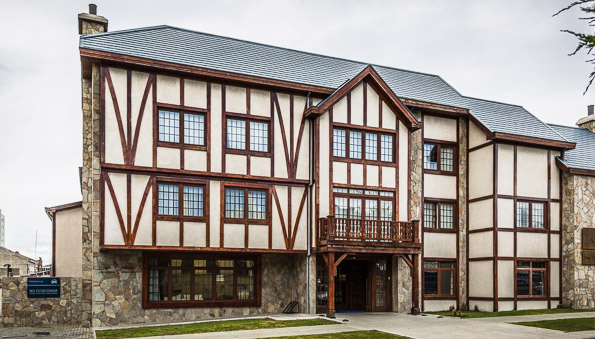
Hotel Rey Don Filipe, Punta Arenas
The hotel Rey Don Filipe was pleasant and modern and I was now sharing a room with my future shipmate buddy, Dominic. We had some free time to explore Punta Arenas, before each having to attend a boot fitting to size up the rubber boots we would required for our trip to the Antarctic. A presentation from the Antarctica XXI tour operation team followed a little later which included things like safety and how to dress for the zodiac boats and landings. The each member of our group, suitable adorned with rather large name tags, were asked to stand up and say a little about ourselves and our passion for photography. It was an eclectic mix, with the majority from the USA and Canada, but also a sizeable (and noisy) bunch from Australia, as well as a smattering of Brits, Swiss, Polish, Irish and even someone from Israel. All, I have to say, a pleasant and friendly bunch; rather different from my previous trip!
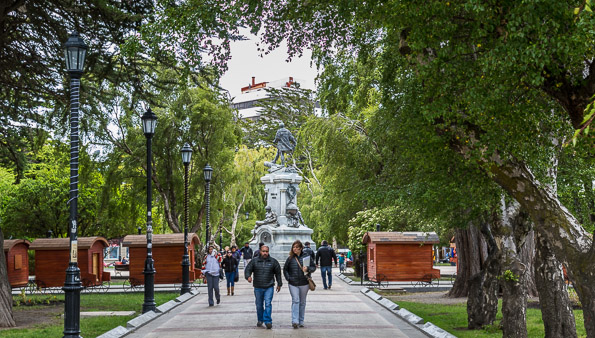
Memorial to Ferdinand Magellan in Punta Arenas.
The day ended with a trip out to one of Punta Arenas premier restaurants set within a delightful old colonial house. Good food and plenty of wine were enjoyed by all during which it was announced the weather for the following day was good and our flight to Antarctica would go ahead in the morning. You could feel the anticipation rising. We were going to Antarctica!
Journey to Antarctica – Day 2
- At January 28, 2014
- By John
- In Antarctica, South America, Travel
 0
0
Santiago
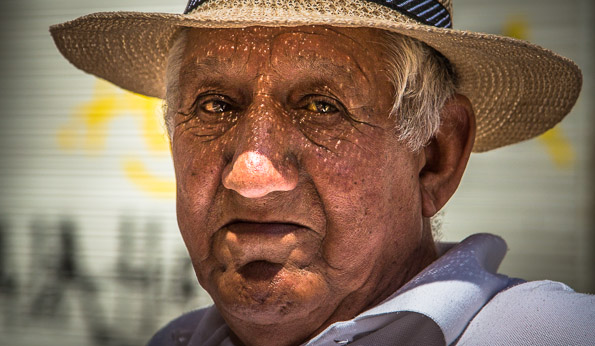
Old gentleman in Santiago
Today we had a chance to relax and explore a little of Santiago whilst the rest of the Antarctica participants arrived from their various destinations. Despite just 3 hours time difference from the UK I felt pretty smashed from the previous days journey and slept through till 5:30 am local time. I chilled out in the morning, chatting with several other members then went for a walk around central Santiago with a few of the other photographers, taking in the relaxed Sunday afternoon atmosphere and a chance to meander the streets and do a little street photograph. Snapshots of my journey. I’m not one for street photography but snapped several of the colourful local people.
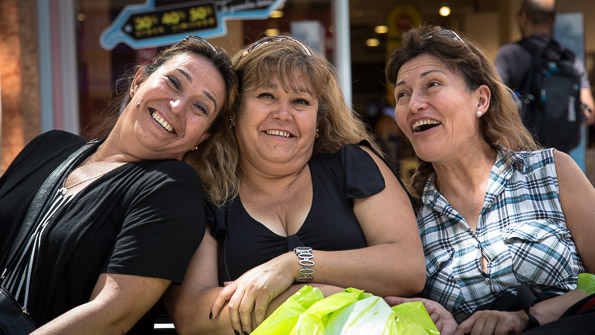
Some local ladies posing for the cameraman
In the evening we got to meet the Luminous Landscape crew, Michael Reichmann, Kevin Raber, William Neill and cameraman Chris Sanderson, for drinks and and introductory lecture about our trip. However, an extremely early checkout scheduled for a 3am departure to the airport necessitated an early retirement for me, to try and catch a few our sleep before our 6am flight down to Punta Arenas in southern Chile.
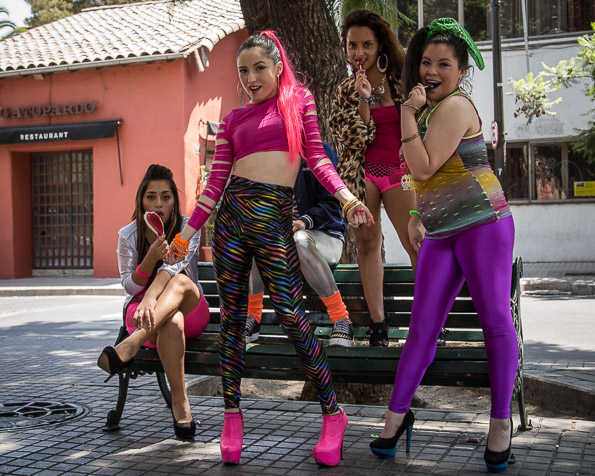
The colourful street life in Santiago
Journey to Antarctica – Day 1
- At January 26, 2014
- By John
- In Antarctica, Travel
 0
0
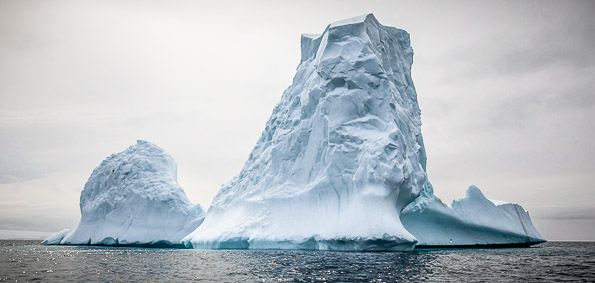
Well this is something new for me. Writing a blog whilst on the plane. I’m not usually one of those who gets a laptop out and works while flying, and in this case I’m travelling without my iPad, but do have my new 11-inch Macbook Air. The Macbook Pro has been swapped for a rather diminutive but extremely lightweight Macbook Air. The reason? Well I’m on my way to Antarctica (currently en route to Santiago), but this time flying from Punta Arenas in Southern Chile to King George Island in the South Shetlands Islands, where I board my ship. I’m restricted to just 20kg on that flight which includes both check-in and hand carry luggage. I’ve spent the last couple of days swapping in and out gear trying to get the weight down, which hasn’t been an easy task, and so far I haven’t quite managed it. Luckily we’ve been told we can leave some stuff at our hotel in Punta Arenas, so my final decisions on what goes can be addressed later.
Later …
Well I’m now at my hotel in Santiago. I’ve chosen to arrive a day prior to the tour start since I simply don’t trust the airlines enough to get you and your baggage to your destination together on time. It seems at least half the participants thought the same, and one at least has arrived without his bags. My BA/Iberia flights were basic but OK; the Madrid to Santiago section a rather tedious 12-1/2 hours, but I did manage to get a few hours sleep. I felt quite rested upon arrival but the feeling of relaxed anticipation was soon dissipated by the experience getting through Santiago’s Comodoro Arturo Merino Benítez International Airport. The queue for immigration in a hot un-aircondition hall was horrendous, and took almost an hour an a half to get to the front of the line. That was followed by utter chaos in the baggage hall. There was no indication what-so-ever of my flight or which baggage carousel to collect it from. I eventually found it buried under several others piled up in a corner. At least it had arrived. An almost equally long queue then followed to get my bags scanned at customs before I finally made it out to the arrivals hall. Quite the worst 2-1/2 hours airport experience I’ve encountered for many a year.
Luckily I met one of the course instructors, Kevin Raber, just about to get into a taxi, so shared the ride to our hotel in central Santiago. Now rested, showered, and beer in hand, I’ve had the chance to chat with some of the other people about to share this voyage to Antarctica.
Return to Antarctica
- At October 26, 2013
- By John
- In Antarctica, Gear
 1
1
What Equipment will I take his time?
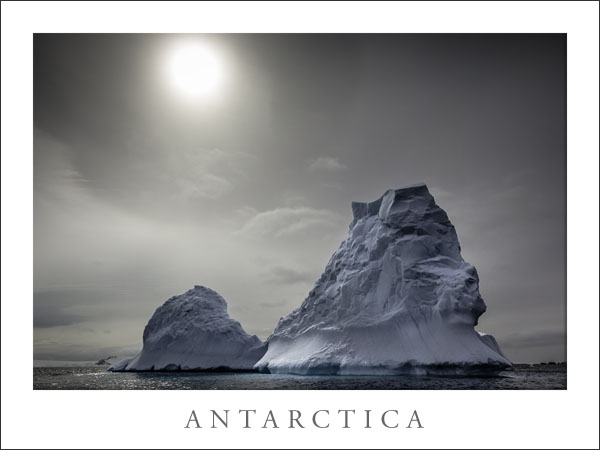
In late January 2014 I hope to return to Antarctica, this time avoiding the dreaded seasickness of the Drake passage by flying to King George Island from Puntas Arenas in Chile, before boarding the Ocean Nova. So what equipment will I be taking this time and what lessons did I learn from my trip two years ago?
Camera Bodies
The last time I travelled with two 5D mark-II’s, having purchased a second body just prior to my departure. Relying on just one body seemed far too risky for a trip of this nature and rumours of some 5D-II’s failing on previous trips, falling foul to the damp wet weather, did cause concern about their reliability. Thankfully mine came through in fine fettle despite the exceedingly damp, overcast conditions, but one did succumb in similar conditions in Iceland several months later. I also found two bodies quite advantageous when shooting from the decks of the ship; one kitted out with a longer lens, with the other a wide angle zoom. Having two cameras around ones neck can be a bit of a hassle, so having at least one of the bodies fitted with a sling style strap is almost a pre-requisite so highly recommended.
I had planned to sell the second 5D-II body upon my return to the UK but that never transpired and it was eventually traded in against a brand new 5D-III. The mark-III is a far better performer than the mark-II in terms of focusing, and higher ISO, and has that all important weather sealing, so I’m now contemplating upgrading my remaining 5D-II to the mark-III for my return trip.
Lenses
I took more lenses than I really needed last time around, but since I may face far stricter weight restrictions this time, I’m planning to cut down next trip. The lenses on my first trip included:
- EF 16-35mm F/2.8 L USM zoom
- EF 24-105mm f/4 IS L zoom
- EF 300mm f/2.8 IS L
- EF 70-300mm f/4.5-5.6 IS L
- TS-E 24mm f/3.5 MII
You may think this a rather odd selection of lenses to bring, but the trip included a few days in Patagonia, for which I’d included the tilt and shift lens. However, there was at least one professional photographer onboard who used a TS-E 24mm whilst in Antarctica. I never did.
I found a lot of the people shooting from the deck of the ship (and some from within the zodiacs) often carried two cameras at once, one equipped with a long zoom and the other with a utility zoom lens. I ended up doing the same and found it very useful whilst especially when cruising. With encouragement from Seth Resnick, one of the workshop instructors, I also rented a EF 300mm f/2.8 lens. This is a super sharp lens, and one of the best in Canons arsenal, but personally I found it a little too heavy and bulky to shoot successfully hand-held, especially from a zodiac, unlike Seth who used his all the time but has much better technique and experience handling this lens. Most of the photography on this trip was hand-held from zodiacs or from the decks of the ship, often in gloomy, dull, overcast weather, so lenses with IS or VR were certainly worth their weight in gold.
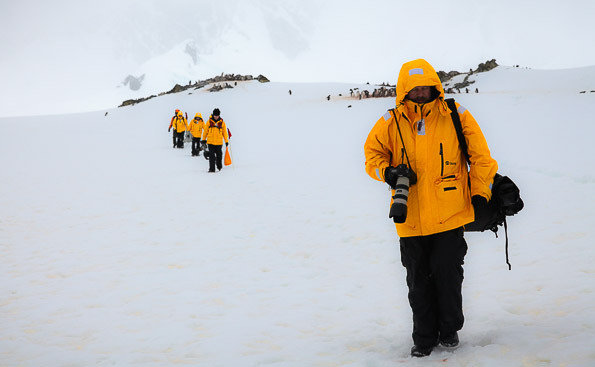
Most of my shots were taken with the EF 24-105mm f/4 and the EF 70-300 f/4-5.6L IS USM lenses. The later is a superb, very sharp zoom lens that’s very easy to handle, thus I found it far more useful than the EF 300mm f/2.8 so the difference in sharpness shooting hand-held became negligible. The EF 24-105mm f/4 is not the sharpest zoom in the Canon range, and probably the weakest in my lens selection. However the 24-105mm zoom range actually made it probably the most useful and eventually the most used lens when shooting from the zodiacs. I also took a 16-35mm wide angle zoom and a 24mm T&S lens but neither saw much use in Antarctica. Both were used in Patagonia afterwards however. I regret not trying the EF 16-35 mm f/2.8 much from the deck of the ship, as at times we got so close to some huge icebergs that a really wide angle lens would have been the better choice, and other photographers bagged some great shots where I missed out.
For this trip I’m planning on taking the following.
- EF 16-35mm F/2.8 L USM
- EF 24-105mm f/4 L IS
- EF 24-70mm f/4 L IS
- EF 70-300mm f/4.5-5.6 IS L
You’ll notice the absence of primes. Shooting hand-held from zodiacs bouncing around in the water really renders any advantages in sharpness from a prime lens almost useless. Unless of course, you have great technique. I’d much rather have IS lenses and the ability to reframe as best as possible. For me the zooms are just more practical on a trip of this nature. Added to my lens selection this time around is the new EF 24-70mm f/4 IS L zoom which out performs my 24-105mm hands down. However, the later is still there for backup. I could have gone for the new 24-70mm f/2.8 which is sharper (not by much), but it lacks the all important IS.
Shooting Techniques
One major regret was that we were given very little guidance from the course instructors on shooting techniques. This was really disappointing as it took me a good couple of days to get reasonably comfortable shooting hand-held from zodiacs. My approach was initially more akin to landscape photography, and my own inability, trying to shoot with apertures of f/11 or smaller to maximise depth of field, when really f/8 was quite sufficient. I also should not have been afraid to have used higher ISO settings either, rather than trying to keep below ISO 400, which unfortunately resulted in many of my earlier attempts lacking in sharpness and so few keepers. In this respect the 5D-III should prove a much more capable camera under these conditions with its far superior high ISO performance and I wouldn’t really worry that much shooting from 800-1600 ISO if necessary.
We had pretty overcast weather almost throughout our Antarctic trip but even then you still needed to compensate around +1-1/3 to +1-2/3 stops for all the white snow. Shooting in aperture priority mode seemed the most logical method to adopt and this worked best for me. On the few occasions I used the tripod during onshore landings I may have used manual mode.
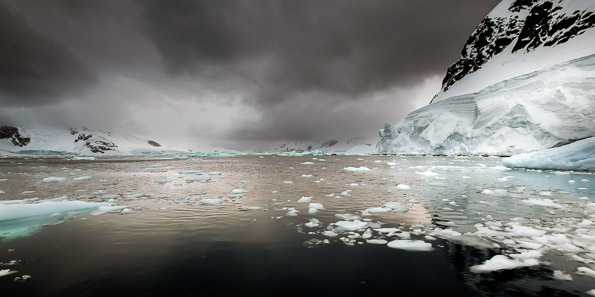
There were 73 photographers on our trip, and at times shooting from the decks was more like paparazzi at a film premier, with the sound of shutters rattling off in machine gun like bursts at time. I’m sure some must have shot on auto-drive with their finger continually pressed on the shutter button at times. God knows how many memory cards they must have got through. Unfortunately I too, got pretty wrapped up in this style of shooting at times, thinking it was the thing to do, and I really wish I’d put a bit more thought into my compositions at times, and taken a more time to fully evaluate the scene before me rather than the smash and grab technique favoured by many. This time I’ll be far more selective.
Shooting from zodiacs bouncing around in the zodiacs was a steep learning curve and something completely new to me. You’ll just have to practice at that, and try and keep the shutter speed high enough. That’s why I find IS lenses so invaluable. One thing I will say is that don’t be afraid to instruct your helmsman to slow down and make a repeat pass if you don’t get the shot. I was just too dam polite to start off with!
Tripod
I took my Gitzo GT 3541-LX tripod but it didn’t use that much use. It was used on some Island landings for landscapes shots, and it was definitely needed as the light was often poor. It wasn’t much use in the snow however which is very deep, so if you do plan to use one some snow feet may be a wise investment. Not many of the photographers took tripods but I much prefer to use one when I can. I was tempted to take a light weight tripod or even just a monopod but it was pretty dam windy in places, so a sturdy tripod was perhaps a better choice, but bulky of course. I’m going again in January, this time flying to King George Island and will take a tripod, although I’m going to have much tighter weight restrictions this time.
Surprisingly I saw no monopods used on our trip, but there again they are probably not that advantageous shooting from the deck of a ship, and of no use in the snow (unless with a snow-shoe), but they have got to be better than hand holding, especially if using a heavy long lens. I did actually try using EF 300mm f/2.8 on the tripod from the deck of the ship, occasionally with extenders too. In each case I had the head loosened and used it gimbal-style. I’d seen Art Wolfe do this on Travels To The Edge and it works pretty well providing you’re cruising smooth waters. Well worth a try.
Backback
I took my rather large Lowepro Pro Trekker 400 AW photo backpack, but this proved too bulky and really too awkward for use in the zodiacs. Eventually I gave up and ended up leaving the backpack on the ship and taking my cameras on the Zodiac in just a simple dry bag. This worked very well, but I generally only ventured out with one camera and perhaps a second lens on these occasions.
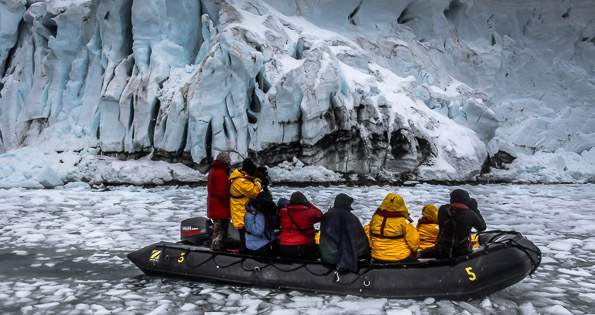
I’m going to take my gear down to Antarctica in a Gura Gear Bataflae 26L this time, which is smaller and lighter than my Lowepro Pro Trekker 400 AW. For zodiac use I’ve ordered a Mad Water Waterproof Sportsman’s Backpack. This a not a camera bag, just a fancy but inexpensive roll-top dry bag. I’m looking at putting in some cheap padded camera inserts inside and have seen quite a selection on eBay and Amazon, so I’m going to experiment a little before my departure. I was very tempted by the new Lowepro Dryzone BP 40L backpack, but it looks rather large, is quite expensive and as yet it’s not available here in the UK.
Keeping Your Kit Dry
If your going to be photographing from the zodiacs it’s inevitable you’re going to get your camera and lenses splashed, plus you may encounter precipitation in the form of rain, sleet and snow and all at the same time! Getting your kit in and out of a camera bag in zodiac doesn’t really work, especially with 7 or 8 other photographers. You need something quick for rain or snow. A simple inexpensive drybag proved by far the quickest and easiest solution. Mine was a Exped Large (13L) Drybag and it was probably the best purchase I made prior to the trip. Be sure to have at least a couple. It was also suggested I purchase an SLR rain hood, such as the Kata E-702 PL Pro Light Rain Cover, which unfortunately I did. I can’t recommend these at all. They are bulky, awfully difficult and time consuming to put on, and make operating your camera terribly difficult, so I’d avoid these like the plague. Far better are the polythene rainsleeves from Optech, which are cheap, see through, and come in packs of two for just over a fiver. If you want something a little more substantial that doesn’t take up too much space, then check out the Storm Jackets from Vortex Media. They are rather expensive but are practical and work well. I took one with me but found the Optech covers my preferred choice. Just make sure you have them tied-on when it gets windy.
You’re going to need plenty of microfiber lens cloths to wipe the spray from your lenses, but rather than purchasing expensive ones from the camera dealers, I found microfiber camping towels far better. They seem to be pretty much the same material, lint free, and much larger. Take several, as by the end of one zodiac trip they’ll probably be wet through so it’s best to have some backups. After a while your lens front may cloud up with salt residue, so a lens spray is recommended. I used the ROR Lens & Filter Cleaning Solution which works very well.
Laptop
Last time around I took my 15-inch MacBook Pro, and backed up all my photographs each evening when on-board ship. I worked on some, but to be truthful I was so knackered each day I left most of my post processing to when I got home. I’d really like to take this again but I’m limited to only 20kg on my flight out from Chile and that includes hand luggage, so I may have to ditch the laptop this time around. If I can’t take it, I may just take an iPad instead, and take lots of SD & CF and record on both as a back up. The jury’s out on which way to go at present.
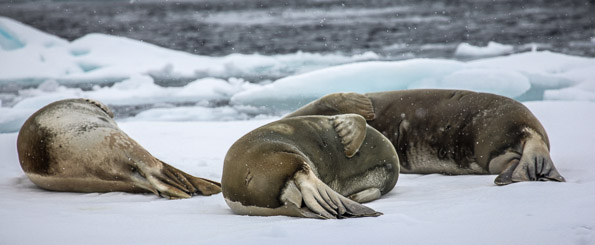
Airline Travel
The airlines seem to have become incredibly picky these days with baggage limits, and most now weigh your carry-on baggage at check-in too. This can be really problematic for photographers as our equipment is not only valuable but heavy too, and none of us wish to risk putting anything in the hold unless within something like Pelican hard case. Carry-on limits vary from as low as 6kg to 23kg, but most are around 10-12 kg. Most of us also travel with a laptop too, so with camera bodies, lenses and accessories, that can result in one pretty heavy backpack. On my last trip my backpack weighed around 16 kg (35 lbs). Of course you’re never going to get his past check-in if weighed, but there are some workarounds you can try.
My Lowepro Pro Trekker 400 AW photo backpack has a detachable bum-bag (waist-pack) which proved incredibly useful at check-in. It’s big enough to hold my 16-35mm, plus my passport and a few other odds and sods. The other trick is to wear a big coat (note: wear not carry), in my case a Begrhaus rainproof jacket, which also has large pockets, big enough to hide two other lenses. Surprisingly most airlines also allow a laptop in a slip case in an addition to your normal one hand-carry item. Thus I removed my laptop too and this never got weighed. My back weight was reduced to around 12kg and all the items were duly returned there once check-in was completed.
Of course all this regulation is complete nonsense on the part of the airlines since you can buy copious amounts of quite heavy, duty free goods when through passport control, and walk straight on the aeroplane. It’s really just a ploy to charge you more money, but I can probably envisage the day they will require us to get on the scales at check-in. Until that day arrives these ploys should work.
One other problem people will face traveling down to Ushuaia, is that Aerolíneas Argentinas have a 12kg check-in baggage limit. Luckily this seems to be rarely enforced, and my luggage, which was around 23kg was never even weighed. That aside, it’s going to be pot luck as occasionally some traveller will be charged excess. None on our trip were charged.
This trip I’m flying on Aerovias DAP from Puntas Arenas in Chile who operate a strict 20 kg weight allowance, and that includes your hand luggage. This trip is going to be a real challenge weight-wise.
Antarctica 2011 Trip Review
- At January 09, 2012
- By John
- In Antarctica, Clothing, Workshop
 1
1
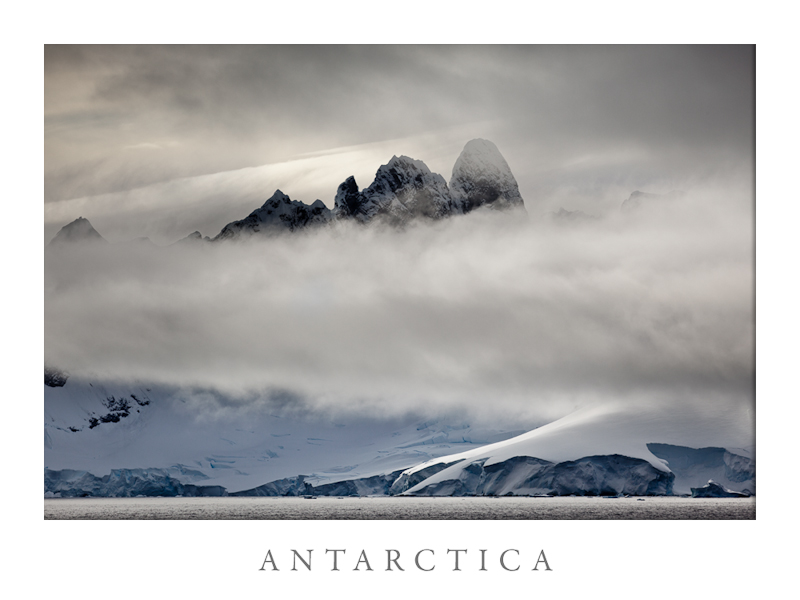
This is a blog I started quite some time ago, but for some unknown reason or other it got put on a back burner and I never got around to finishing it, until now. It’s been quite a while since my trip to Antarctica and I’ve been wanting to write about some aspects of this amazing trip. I read Andy Bigg’s (one of the workshop instructors) excellent article entitled Antarctica – What Worked and What Didn’t the equally excellent Antarctica Debrief by professional photographer and fellow workshop attendee Josh Holko. It’s very much something along these lines that I wish to pervey, so this is my take on the trip in deference to the two already very well written blogs.
Read More»Voyage to Antarctica
- At November 30, 2011
- By John
- In Antarctica, Location, Travel
 0
0
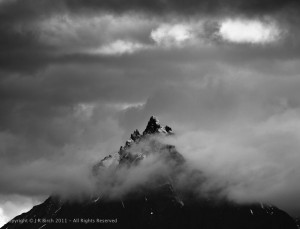 Later today I board my cruise ship the Ocean Nova, to begin my 10 day trip around the Antarctic Peninsular, hopefully the trip of a life time. Antarctica is a place that has long fascinated me from first hearing the amazing feats of Ernest Shackleton in my teens, then later in my first post university job where I worked with a guy who had just spent 18 months working on the British Antarctic survey, and who’s slides I found simple amazing. Now I’m about to embark on my own Antarctic adventure as part of a 73 strong photographic party. The journey down to Ushuaia on the southern most tip of Argentina, was rather long and arduous, 37 hours from door to door, 3 flights, cramped seats and a lot of waiting around in airports, but you can’t help be impressed by this ever growing tourist destination nestled into the southern tip of the Andes Mountains of Tierra del Fuego province.
Later today I board my cruise ship the Ocean Nova, to begin my 10 day trip around the Antarctic Peninsular, hopefully the trip of a life time. Antarctica is a place that has long fascinated me from first hearing the amazing feats of Ernest Shackleton in my teens, then later in my first post university job where I worked with a guy who had just spent 18 months working on the British Antarctic survey, and who’s slides I found simple amazing. Now I’m about to embark on my own Antarctic adventure as part of a 73 strong photographic party. The journey down to Ushuaia on the southern most tip of Argentina, was rather long and arduous, 37 hours from door to door, 3 flights, cramped seats and a lot of waiting around in airports, but you can’t help be impressed by this ever growing tourist destination nestled into the southern tip of the Andes Mountains of Tierra del Fuego province.


